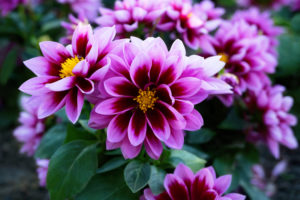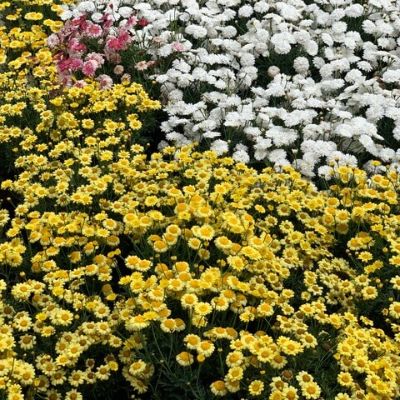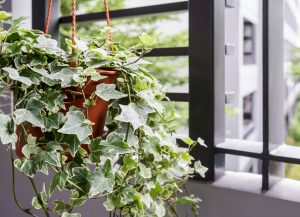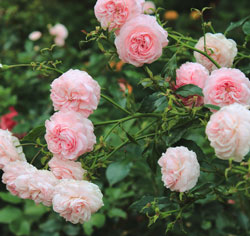You might have seen the cottgecore aesthetic springing up everywhere online and even in your local community. And there’s little wonder why. Cottagecore is a soothing, relaxing aesthetic that revolves around a simple, romanticised idea of rural life. It is commonly associated with vintage clothing, baking, florals, fresh fruit, clean air, cut flowers, and quaint thatched cottages with overgrown gardens. And it is these gardens that are making their way to our backyards. Today we are going to look at what makes a traditional cottagecore garden, and the perfect cottage plants and flowers for your garden.
What Makes a Traditional Cottagecore Garden?
 The cottagecore aesthetic is based off the traditional cottage garden. The Royal Horticultural Society in the UK says the cosy cottage-garden is exemplified by traditional English garden plants, with delphiniums, foxgloves, lupins, and poppies being the most popular flowers. The cottage garden is created using overlapping flowers in striking hues, with pops of bold colour scattered throughout, bordering overgrown, wild lawns. The idea is to create a relaxed tapestry of colour, cleverly constructed to mimic banks of wild, overgrown flowers. These gardens feature year after year of flowering and foliage plants, including annuals.
The cottagecore aesthetic is based off the traditional cottage garden. The Royal Horticultural Society in the UK says the cosy cottage-garden is exemplified by traditional English garden plants, with delphiniums, foxgloves, lupins, and poppies being the most popular flowers. The cottage garden is created using overlapping flowers in striking hues, with pops of bold colour scattered throughout, bordering overgrown, wild lawns. The idea is to create a relaxed tapestry of colour, cleverly constructed to mimic banks of wild, overgrown flowers. These gardens feature year after year of flowering and foliage plants, including annuals.
Soft lines, unstructured flowerbeds, and heirloom varieties are the epitome of the cottagecore garden. Perennials and annuals are mixed by height to create a ground level sweep of incredible colour, with spontaneous background highlights that can be enjoyed all year round.
Another reason the cottage garden style is seeing a renaissance in the form of cottagecore is its benefit to the environment and wildlife. Pollinating insects, particularly bees, love the flowers and plants that exemplify cottagecore, making these gardens wildlife havens. And some gardeners are even mixing in vegetables amongst their gardens to take this cottage-living aesthetic to a whole new level.
Even those renting or living in apartments can enjoy this aesthetic as most of the flowers and plants that are part of the traditional cottage garden can be grown easily in pots, planters, and windowsills. Below are some of our favourite, essential cottagecore flowers.
Our 20 Favourite Cottagecore Garden Flowers
1: Anemone
Also known as windflowers, anemones are well-known for their beautiful, nodding flowers that sit on long, wiry stems. Sometimes mistaken for poppies, anemones come in a wide variety of colours and sizes, with varieties blooming in spring, summer, or autumn. Most spring anemones are considered ephemeral plants, meaning the foliage will die back in summer and the plant will go dormant. This will happen faster if faster if the soil is allowed to dry out too much or too often. Keeping the soil evenly moist is important to prevent the foliage from drying up or the leaf edges turning brown and crisp, especially for autumn blooming anemones.
Anemones prefer full to part sun and, as mentioned, evenly-moist, well-draining soil. They can reach between 1-3 feet in height.
2: Bellflower
The bellflower is a super easy to grow perennial perfect for gardeners of all skill levels. They produce beautiful white, pink, purple or blue flowers that make the perfect backdrop to the brighter pops of colour you will introduce with your other flower varieties. They can help soften the garden, giving it that dreamy, relaxed feeling. And, like most cottage flowers, they are great for cutting meaning you can bring these dreamy colours indoors – perfect for those who like cottagecore’s offshoot aesthetic, fairycore.
Also known by their scientific name, Campanula persicifolia, bellflowers grow to 3 feet tall and will thrive in full sun to part shade. Ensure you always plant in well-draining soil and water when the top inch of soil has dried out.
3: Clematis
One of the best climbing plants for the cottage garden, clematis is hugely versatile. It can be grown over walls, fences, pergolas, trellises, and even obelisks for a whimsical, overgrown feel. And with different varieties flowering in almost every month of the year, clematis is ideal for ensuring your cottagecore garden has stunning colour all year round. If you plant to grow your clematis over a large structure, it will need to have support in place before planting. They prefer rich, fertile, and well-draining soil and full sun to partial shade.
 4: Daisy
4: Daisy
Daisies are a classic cottage garden flower but often overlooked, these days, in the face of more extravagant flowers like peonies and anemones. But with their bright white flowers and gorgeous yellow centres, daisies are incredibly flexible when it comes to the cottagecore garden. They can be incorporated into garden beds to create a neutral white for brighter colours to play off, and around borders where their naturally wild-look growth makes for ideal unstructured edges. And there’s nothing more attractive in cottagecore than a daisy-studded wild lawn. They are also perfect for cutting and making attractive posies.
Daises come in a wide variety, including coloured varieties, making them ideal for any cottage garden. They can reach 3 feet tall and prefer full sun to part sun, and well-draining soil. Water when the top inch of soil has dried out.
5: Delphinium
An older style cottage garden flower, the delphinium has seen a resurgence with the advent of cottagecore. They are one of the most regal cottage garden plants, rising above other flowers, allowing you to create varied heights and truly capture that wild look of the traditional cottage garden. They come in a variety of soft shades including blue, white, lilac, pink, and purple, and truly steal the show in every garden. However, because they can reach a staggering 6 feet tall, they will need to be staked to protect them from the wind. But these flowers are well worth the work, especially for the serious cottagecore enthusiast.
All varieties of delphinium require full sun and well drained soil. Again, ensure the soil dries out between watering.
6: Foxglove
The foxglove is considered a true woodland beauty and reliable produces stunning upright spikes of bell-shaped flowers in a myriad colours, though traditionally they were only grown in blue, purple, pink and white. Most foxglove varieties will self-seed and appear each year in your garden. However, in the first year, only a base rosette of leaves will be produced when growing from seed. All foxglove varieties like full to part sun and like well-drained soil. They can reach 2-5 feet, depending on variety.
Be cautious, though. All parts of the foxglove are highly poisonous and should kept out of the reach of pets and children.
7: Geranium (Perennial)
Geraniums are considered the perfect cottagecore garden plants and are used heavily in traditional cottage gardens. Coming in large and small varieties, they allow gardeners to create varied heights of pretty colour in early summer. They also have gorgeous autumn foliage, allowing you to enjoy swathes of colour in each season. Geraniums like full to part sun and medium-moist, well-draining soil. Most varieties reach up to 18 inches tall.
8: Gladioli
Also known as sword lilies, gladioli are pretty flowers that are easy to maintain. They have a grassy, sword-like foliage and funnel-shaped flowers that grow on tall, flower spikes. The flowers come in a wide array of colours and are ideal as stunning background plants in cottage gardens. You can plant them every 4-6 weeks so you have a continuous staggered display of colours. They are also ideal cut flowers and look stunning in any flower arrangement. They prefer full sun in light, well-drained soil. Gladioli can reach up to 1.5m tall.
9: Hollyhock
A low maintenance, eye-catching plant, hollyhocks have large, colourful flowers in a nearly-black, red, purple, white, and yellow. These gorgeous plants can reach between 6-8 feet tall, depending on the variety and make for the perfect addition to any cottage garden. The thrive in full sun and medium-moist, well-drained soil.
 10: Hydrangea (Bigleaf Hydrangea)
10: Hydrangea (Bigleaf Hydrangea)
Hydrangea are spectacular, dramatic plants that look incredible in any garden, but look most wonderful in the cottagecore garden. With so many incredible varieties to choose from, the bigleaf hydrangea shrub produces large clusters of flowers in pink, blue or white in early summer. This makes it ideal as it brings in a burst of colour after many of the spring flowers have already spent for the season. And these flowers make perfect cutting flowers, adding drama to any arrangement.
Hydrangea likes part sun to full shade and a medium-moist, well-drained soil. Choose the perfect place for this shrub as hydrangeas can reach 10 feet tall!
11: Iris
Irises are beautiful, fragrant flowers that offer flowers in a rainbow of colour and a myriad of sizes. The Siberian iris is often the preferred cottage garden variety as it has whimsical, grassy leaves, graceful flowers, and isn’t appealing to rodents like rabbits. Iris prefer full to part sun and a medium-moist, well-drained soil. Most iris varieties will reach around 4 feet tall.
12: Ivy (English Ivy)
When we think of cottages and cottage gardens, we invariably imagine a rambling farmhouse style home covered in ivy. Which means it is little wonder that English ivy forms a large part of the cottagecore garden and aesthetic. Superb climbers, English ivy can cling to almost any surface and is incredibly easy to care for. Ivy is ideal to use as a screen or as over for ugly walls and structures. It is also ideal for groundcover, especially under trees where grass refuses to grow.
English ivy likes shade and organically rich soil. Plant about a foot apart for quick coverage.
13: Lavender
When we think of cottage and English gardens, the first thing that comes to mind is lavender. And we can understand the appeal. Lavender is not only beautiful all year round with its silvery leaves, but the stunning flowers have a wonderful fragrance. The flowers of the lavender come in a variety of violet shades, as well as white, and a particular favourite of pollinators like bees. Lavender is also wonderful for drying and using in sachets or other craft projects.
Grow lavender in full sun with a well draining soil and expect these robust shrubs to reach 1-2 feet tall and easily as wide.
14: Peony
Peonies are the most popular flowers right now, especially in bridal bouquets. And it is little wonder. Peonies are still considered one of the most romantic flowers with their showy, petal-packed blooms. Flowering in mid-to-late spring, peonies not only look fabulous in the cottage garden, they also give off a wonderful fragrance and are almost pest-free. Coming in a variety of colours, peonies are also ideal as cut flowers, lasting up to 3 weeks in a vase. You can also dry them to make them last longer.
Peonies like full sun to part shade and medium-moist, well-drained soil. They can reach 3 feet tall, depending on the variety.
15: Poppy
Poppies are one of the most coveted flowers for cottagecore gardens. Coming in a vide variety aside from the renowned ANZAC poppy, annual poppies add vivid colour to every garden. They are incredibly easy to grow and self-seed, allowing them to appear each year. Poppies are best grown from seed as they unfortunately do not transplant well. Scatter them in among you late spring-blooming perennials for best garden design. Poppies need full sun and grow from 1-3 feet.
 16: Roses
16: Roses
One of the best cottage garden plants for both their flowers and smell, roses are a classic in any garden. In fact, many people actively keep segments of garden specifically for varieties of roses, and rose gardens often are a cornerstone of the cottage garden. Incredibly versatile, there is a rose for almost any situation from planting in pots to creating borders, as well as tree roses and climbing roses. Climbing roses, in particular, look stunning grown over walls, fences, pergolas and other large garden structures.
Different varieties will prefer different environments for growth, though most roses like full sun and rich soil fertilised with well-rotted manure.
17: Sweet Pea
These are great summer flowers. Like roses, sweet peas are a true cottage garden favourite, and one of the best cottage garden flowers for cutting. Sweet peas coming in both annual and perennial varieties meaning you can plant to ensure colour all year round. Annual sweet pea varieties are highly scented with frilly blooms, making them great for growing over arches, obelisks, or up canes for the perfect cuttings. Perennial sweet peas are not usually scented, but are very hardy and will bring a swathe of colour to your garden from summer to summer.
Annual sweet peas are very hungry, so you will need to feed with a well-rotted manure. Both annuals and perennials will need to be tied to some kind of supporting structure. Water diligently in hot weather and cut flowers in full bloom so it won’t set seed.
18: Sweet William
A stunning biennial plant, sweet william produces beautiful clusters of fragrant flowers from late spring into early summer. They are ideal for adding dramatic splashes of colour, coming in vivid red, pinks, white, and a variety of bi-colour shades. They also work wonderfully as a cut flower and will attract pollinators to your garden. Sweet william likes full sun to part shade and well drained soil and reaches around 2 feet in height.
19: Tulip
There is no cottagecore flower quite as exotic, beautiful and truly romantic as the tulip. While too many gardeners put them in the “too-hard” basket, considering them difficult, fussy, and unreliable, with a few basic conditions, you will find them incredibly easy to grow! The tulip is the most cross-bred and hybridised of all spring-flowering bulbs meaning there are now thousands of recognised varieties. It is also thought to be the first “collectable” plant due to the staggering amount of varieties available. Tulip flowers are held on very long smooth stems, with the flower being a goblet-shaped when young, becoming more cup-like as the flower ages. The flowers come in almost every colour, including black, but strangely not blue.
To ensure your tulips thrive in each season, it is important to keep watering the plant and leave the foliage alone until it browns off. Then prune the foliage back to allow the bulb to store energy for next year. Tulips can reach 60cm in height and prefer a moist, good-quality, free-draining soil. If planting in pots, always use bulb or premium potting mix.
20: Violet
Violets are ideal in both cottage and market gardens as these charming flowers have edible blooms, perfect for cooking and baking. They are perennials that bloom in both spring and autumn, ensuring you can create a vibrant, year-round garden. They prefer cool weather in full sun to part shade, and evenly moist, well-drained soil. Violets reach 9 inches tall and come in a purple-blue hues, though some even come in white and yellow.
Looking to start your very own cottagecore garden? Visit Aumann’s Building and Garden Supplies today to explore our range of cottage garden flowers. Or contact our helpful staff today to start your perfect garden now!

